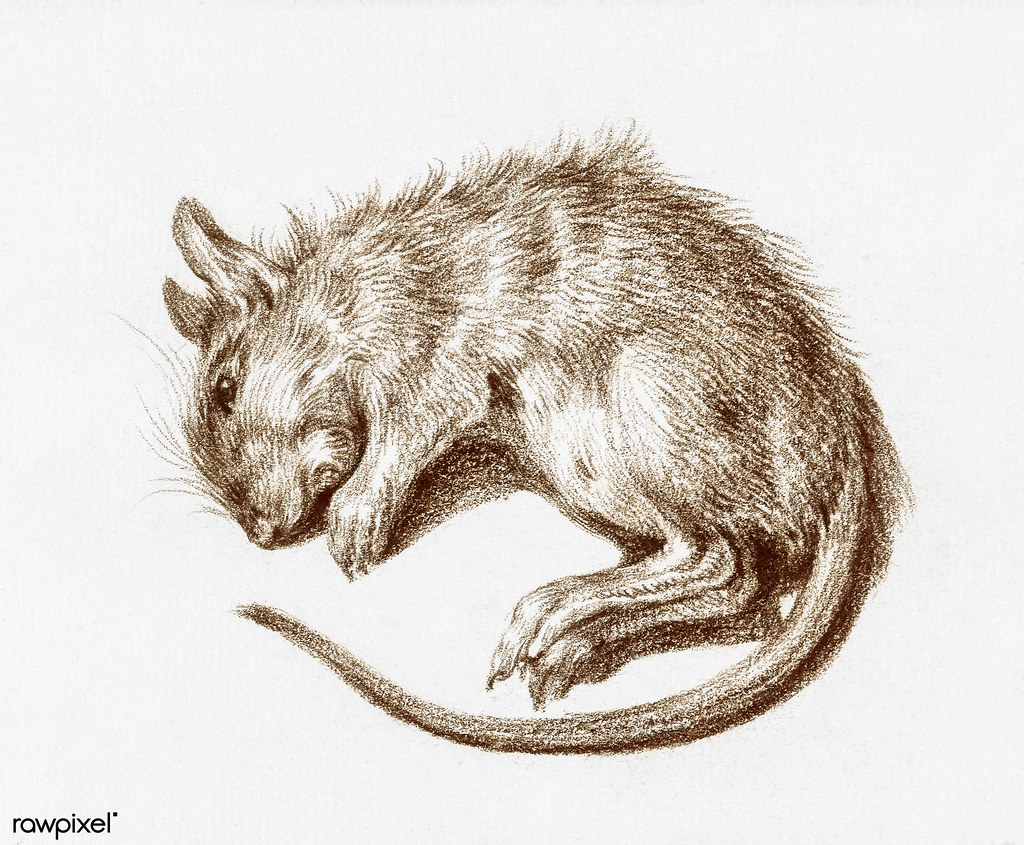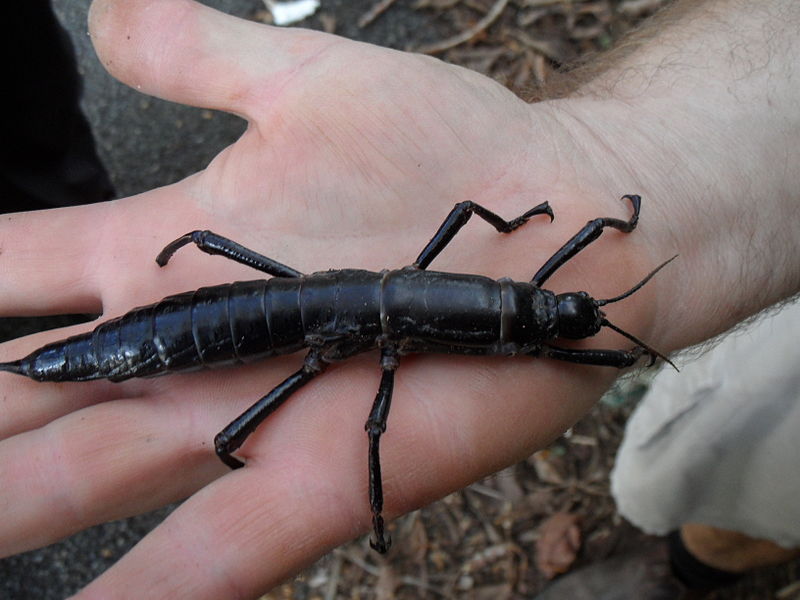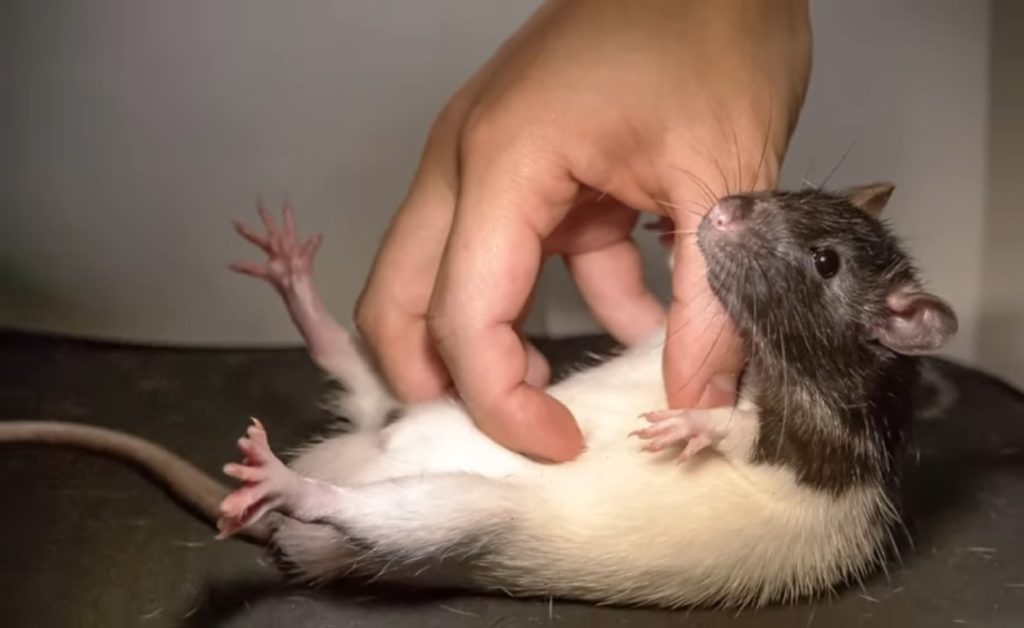Ode to a Dead Rat

THERE’S A RAT lying dead beneath the back porch. He announces himself as I’m sitting on the steps taking a moment of sun with a cup of tea, when that morbid little waft of him sours the ambience. And there he lies, down by my feet in the dark beneath the stairs, stretched out on a cinder block—a slim, slate-colored creature trailing a long scaly tail. He bears no obvious wounds or signs of violence. It’s as if he’s laid himself down for a nap and forgot to wake up.
There’s no big mystery to his murder. You’ll find others like him lying about the neighborhood, dead for no apparent reason. And others soon to be, creeping like slugs in plain sight. You can see the little black boxes tucked against the foundations of my neighbor’s houses, with their little round rat doorways and alluring dark tunnels that lead to the poison bait.
Which is to say that I live in a neighborhood where we routinely kill rats. Those, plus a few more exotic pests that have come to take a particular liking to this singular corner of the world.
Here in the welcoming evergreen environs of subtropical Florida, we live in a global hotspot of unwelcome wildlife. This is the land of notorious 20-foot Burmese pythons, now decimating the legendary fauna of the Everglades. This is the land of feral hogs, nature’s rototillers, bane of fragile plant communities. Here we have enormous cane toads from Latin America, noxious poisoners of pets, and Cuban tree frogs, voracious consumers of the native frogs. We Floridians find ourselves recently inundated by petshop iguanas who freely chow on our shrubbery and rain poop from the palms, and Argentine tegu lizards the size of small dogs who swallow anything that fits in their mouth.
Cane toad: Table for one beneath the compost bin.
We variously label such intruders as nuisances, pests, invasives, aliens. And we chase them down with a vengeance. We have professional bounty hunters patrolling the cypress swamps and city parks for giant pythons and impudent iguanas. We ordinary citizens are advised by our state wildlife agency to kill cane toads by numbing them with a dab of benzocaine and sticking them in the freezer. And of course we dutifully sow poison to rid ourselves of rats, whom the whole world seems to hate on principle.
Yet our household doesn’t subscribe to the killing. Our yard has thus become a de facto demilitarized zone, where the cane toads are ogled rather than stomped under heel, where the Cuban tree frogs that occasionally find their way indoors are snatched from the housecats and returned to their trees. And here, with an admitted pang of sadness, is apparently where poisoned rats go to die.
Which presents a certain dilemma: These are the very creatures who threaten the wildlife whose defense constitutes my life’s work. These are creatures whose deaths by human hands I have otherwise endorsed at length in my writings—but whose actual killing I cannot bring myself to commit. I am the hypocrite, the clandestine draft dodger who publicly sympathizes with the war.
On Death and Resurrection
JUST RECENTLY, to wit, I cheered the news announcing the eradication of black rats on Lord Howe Island. Lord Howe Island is—or was—an evolutionary crucible of birds, insects, and plants found nowhere but on this seven-mile slip of volcanic headlands and subtropical forest nearly 500 miles east of Sydney, Australia. Lord Howe Island has been declared a UNESCO World Heritage Site for its unique assemblage of endemic biota, in spite of what the predatory rats have irreparably destroyed. The rats, which scampered ashore from a shipwreck a century ago, were the chief assailants or accomplices to the extinction of five species of birds, two plants, and 13 insects known only to this tiny island.
Yet now, little more than a year after the rats’ eradication—an historic, herculean campaign, employing 42 tons of poison bait to kill every last one of the island’s 350,000 thousand rats and mice—the survivors have already begun their miraculous recovery.
The Lord Howe woodhen, a naïve, flightless rail that had been driven to within thirty individuals of extinction, has rebounded in the rats’ absence to more than 440 birds at last count. Certain burrow-nesting seabirds, their eggs and nestlings once sitting ducks for the predatory rats, have upped their nesting success from near zero to 70 percent.
And then, there’s the monstrous, marvelous, Lord Howe phasmid, a shiny black stick insect eight inches long. Once common enough that fishermen used them as bait, the island’s inimitable stick insect was extinguished within two years of the rats’ arrival in 1918. It wasn’t until 2001 that scientists searching a formidable sea stack miles south of Lord Howe Island, discovered 24 of the insects huddled beneath a single tree. They collected two breeding pairs, which by 2012 had flourished to more than a thousand descendants, waiting in captivity for the day that Lord Howe Island was once again free of rats—a day that has now arrived.

Lord Howe Island Phasmid: Island oddity back from the dead
Lord Howe Island’s rewilding by rat removal is one of more than a thousand such conservation eradications conducted over the last sixty years, with leagues of professional killers bringing poisons, traps, guns, snares, helicopters, and GIS technology to snuff foreign rats, mice, goats, burros, feral pigs and cats from islands around the world.
For those who reflexively protest such grandscale slaughter as heartless or hubristic, it’s worth having a look at the hands-off alternatives. And no better example to start than with the pointy nosed creature now moldering at my feet.
The black rat, along with its brethren, the brown and Pacific rats—ferried by humanity to nearly every island of Oceania—have been credited with extinguishing 103 species of birds, reptiles, amphibians, and mammals. Innumerable others have been driven by the millions to the brink, literally, with survivors like the Lord Howe phasmid clinging to tenuous little pinpoints of their former range.
Such stats invariably gloss over the grisly details. Seabirds—who for eons have chosen the most remote, unreachable, predator-free islands and seacliffs to raise their young—have no inherent defense when such an otherwordly predator as a rat reaches their shores. They are slaughtered en masse as they sit, not atypically by having their brains chewed out.
Even the humble house mouse—better known as pesky little midnight burglar of our kitchen pantries—has been otherwise unmasked as gruesome killer of some of Earth’s biggest and rarest and most iconic of birds. Far off the southwest coast of South Africa, in a howling Atlantic wilderness called Gough Island, gangs of house mice have been relentlessly attacking albatross chicks three hundred times their size, eating the helpless birds alive. Those birds—including some of the very last of the critically endangered Tristan albatross—are among some two million seabirds on Gough being eaten in such fashion by mice every year.
Consider too, that rats intercept as much as a fifth of the human food supply. They are the creatures notorious for chewing holes through walls, biting infants in cribs, and carrying disease. Some eight hundred years ago, rats helped spread bubonic plague—the Black Death—that killed one in every three people of Europe.
The Joy of Rats
BUT BEFORE YOU sign up to start airdropping the poison yourself, consider one other equally disturbing but far less advertised fact about the rat: How utterly empathic and loving and suffering creatures they have proven to be.
When you hurt one of them—as scientists have experimentally demonstrated—other rats who witness the assault feel their fellow rat’s pain. Their hearts pound. A rat will also forego food to save a drowning companion, or go hungry rather than press the lever that shocks his or her cagemate.
And when you tickle their bellies—as scientists and I have independently demonstrated—they squirm and laugh with joy. Our family once included sixteen rats, whom my wife initially rescued as two woeful souls from the back room of a rural feed store where they were being sold as snake food. We raised them, and played with them, and watched them grow old and die. They were inquisitive, charming creatures who liked to nuzzle, and kiss our necks. We could no sooner have killed one of them than we could one of our cats.

Tickling for science: Researchers tickle rats; rats laugh. © Shimpei Ishiyama, Lena V. Kaufmann,
Michael Brecht
So now which side does the conscience choose in this worldwide war on the rat? Even some of those who have made it their profession to kill for conservation find themselves conflicted. I have interviewed dedicated killers who openly professed to not giving a rat’s ass about a rat’s pain. But I have also listened to others choking on their words as they described an innocent creature dying by their hands.
If only there were a painless, deathless way to stop the carnage. And lo, there’s actually such a hope now being floated by the world’s most invasive-plagued country of New Zealand—an island nation of flightless birds besieged by millions of rats and a rogue’s gallery of fellow four-legged predators from the mainlands. As part of its audacious Predator Free 2050 campaign—to kill every rat, possum and weasel from its borders in the next thirty years—New Zealand is now considering a new, nonlethal genetic technique that features a “daughterless mouse,” a mouse whose offspring are invariably male. And whose offspring’s offspring are invariably male. No more female mice, pretty soon no more mice, period.
This “gene-drive” technology has some conservationists giddy over the potential to quickly and painlessly rid islands of destructive invaders. It has others terrified by the grave unknowns of releasing genetically engineered life. (As in, ‘Oops, you mean those two man-eating tyrannosaurs we released into Jurassic Park aren’t actually sterile after all?’)
So That Others Might Live
SUCH ARE THE quandaries that come from pondering the poor rat beneath the stoop. I’m not suggesting I’d welcome his surviving clan to take up residence in our pantry or greet me every time I open the garbage lid. I’d rather not find rat scat in my fruit bowl. Or catch one of them raiding the cardinal’s nest.
But still I feel a certain sorrow. That rat did not come here to make life miserable for any of us. He along with all his fellow unwanteds were shanghaied from their homelands, by us. They’re the ones we now persecute for making the best of the predicament we put them in.
Yet for every rat or cane toad that I coddle rather than kill, multiple lives will needlessly suffer.
It’s enough to give the mind a moral whiplash. What cold logic and basic math would have me do, my cowardly conscience won’t allow.
Too much for this tiny mind of mine to process. For now, there’s simply a dead rat, to whom I can only give my belated best wishes: That his sufferings were brief, his depredations were few, and his life was full of joy and laughter.
- For a more expansive look at island extinctions and efforts to stop them, read my book Rat Island and visit the site Island Conservation
- Gough Island is where both the horrors and the hopes of island conservation are on vivid display. (Viewer discretion advised.)
- A wonderfully animated and moving film about Lord Howe Island and it’s fantastic stick insect, is simply called Sticky. Watch this trailer, or stream the full movie.
Will, you’ve done it again. Thank you for being so understanding, kind and patient with me, and all of the others enlightened by your work. Miss you lots!
Thanks Christen. It was so much easier when we once believed that Disney World has all the answers.
An expression of pure compassion for situations that punish the unresponsible and conflict the souls of many of us. I will not feel shame for saving something that sensible people don’t like ever again. You have stated this elegantly
Thanks Marianna. Darned if you do, darned if you don’t. Sometimes it seems it doesn’t pay to have a conscience.
Agree with the comments from Christen and Marianna, and with your respective replies. Reflecting on your observations and thought provoking words.
Wasn’t it Kermit who said, ‘It ain’t easy being green?’
Oh, but that more of us would have such a conflicted conscience. I experienced some of what you’ve expressed within this post when I read Rat Island. My soul however, is so intertwined with the beauty and wonder of the natural world that I am 100% behind efforts to remove invasive species that threaten the very existence of other just as unique but much rarer, species. I have shot at (and missed) starlings at our E Oregon property because I know they can outcompete endemic species. If I had killed one, it would have been with some momentary sorrow but deep down would still have felt it proper and even necessary.
I have kept a keen interest in New Zealand’s nascent efforts to rid their islands of rats, cats, possums, and stoats. Just viewed a couple of vids from Pure Salt, a tour company that is now involved in the effort. They kill rats with more humane but also more labor intensive “Goodnature” traps and are having, it seems, some early success. I rejoice at the idea of an expanded rat-free environment for the benefit of so many other species (including my now favorite bird, the kakapo) but do feel that twinge of regret at the cost in other innocent (yet deadly to other) lives.
Thanks for making me think even more deeply about these complicated issues, and making me feel again for the many who must die to preserve those who also deserve… to exist. Glad to see you blogging, always interested in your thoughts, Will.
Keith, so good to hear from you. And yep, the moral battles don’t get any easier. You mention starlings: I’ve raised several as pets, and they are some of the most endearing and amazing of creatures. They would mimic phrases of my girlfriend, in her own voice, to the point that if I couldn’t see who was talking, I couldn’t tell if it was girlfriend or starling. At cocktail hour, the birds would perch on the rims of our martini glasses, and sing to us. At the time I rationalized their captivity by the good I was doing to spare the native birds their competition. But now I question whether the captive life I gave them, even if it involved the run of the house, was humane. I wouldn’t do it again, unless they were crippled, but I am glad to have known them so closely, to have seen what intelligent and charming creatures they are. And now, if I want to rationalize my refusal to kill them, I take credit for having saved many more native birds and mammals and herps by having rescued more than a dozen feral cats from the wild, and found them indoor homes (my own being the main one). We all do what we can, in the best way we can.
Will, I think you are probably one of the most deeply thoughtful and kind-hearted people I’ve had the pleasure to encounter in this crazy world. I hope to have the chance to meet you personally one day, I can imagine a wide-ranging and incredibly satisfying discussion. You’ve made my world better with your writing and just your presence, thank you!
Music to my ears, Keith. You greatly overestimate me, but I’m okay keeping that our little secret.